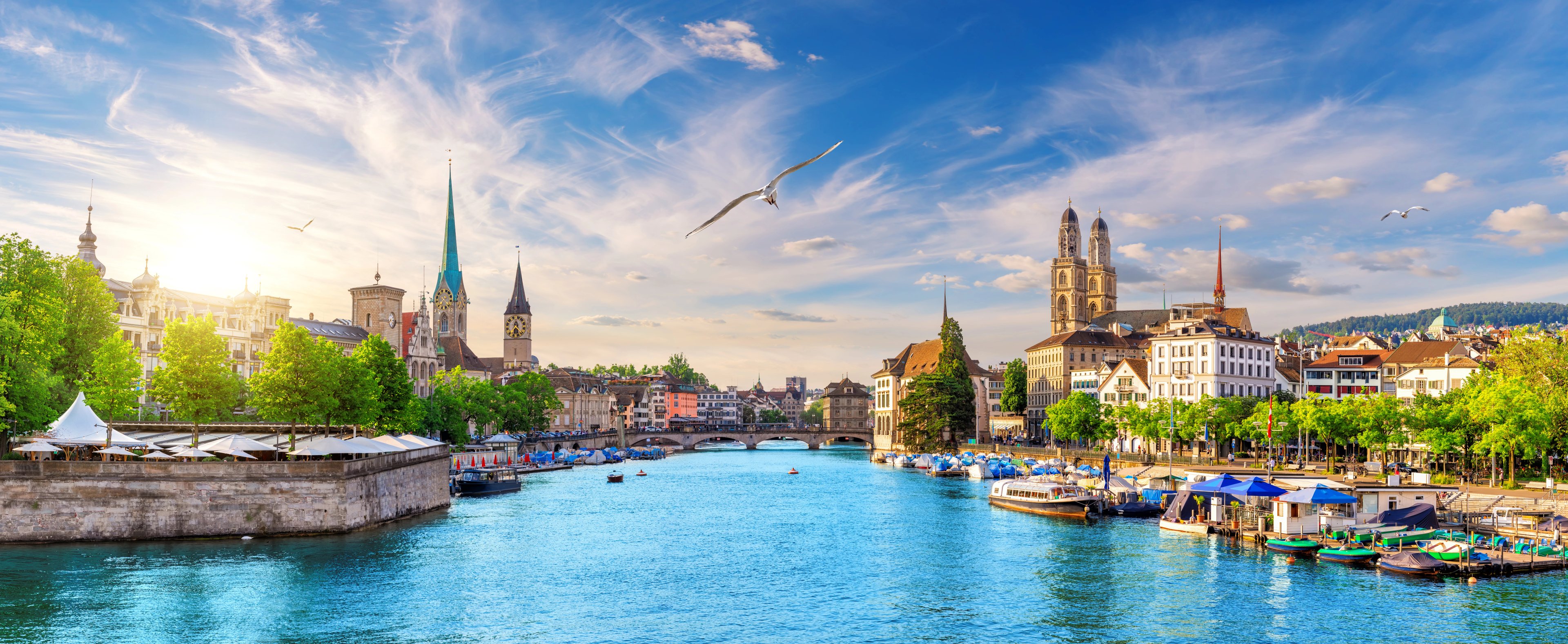Måste-se platser i Schweiz
Upptäck Schweiz främsta naturliga och kulturella landmärken — från sjöar och vingårdar till medeltida städer och alpina pass som är värda resan.

Cykling genom Schweiz handlar inte bara om turerna — det handlar om allt du passerar längs vägen. Sjöstad, bergspass, medeltida byar och UNESCO-listade landmärken vecklar ut sig mil efter mil, vilket ger varje rutt en känsla av upptäckte.
Över landets fem huvudsakliga cykelregioner är detta platserna som definierar Schweiz — från vingårdsterrasser ovanför Genèvesjön till de kullerstensbelagda gatorna i Lucerne och de fridfulla stränderna vid Bodensjön.

Här är måste-se höjdpunkter som varje cyklist bör uppleva längs vägen:
1. Bodensjön & Norra sjöarna
Platta sjövägar, vingårdsbackar och medeltida städer gör Bodensjöregionen till en av Europas mest avslappnade och pittoreska cykeldestinationer. Delad av Schweiz, Tyskland och Österrike, kombinerar den naturskön skönhet med lätt cykling och gränsöverskridande kultur.
Denna klassiska rutt cirkulerar sjön och kopplar samman charmiga städer, slott och hamnar — var och en erbjuder en inblick i regionens blandning av schweizisk precision och bayersk värme. Längs vägen sticker dessa höjdpunkter ut:
2. Centrala Schweiz (Luzern och omgivningar)
I hjärtat av landet är Centrala Schweiz där Schweiz historia — och några av dess mest ikoniska landskap — sammanstrålar. Sjöar, föralpska kullar och charmiga städer skapar en region som perfekt balanserar kultur och landskap.
Denna rutt fångar Schweiz essens i miniatyr — fjordliknande sjöar, böljande klättringar och vykortsperfekta städer. Den är idealisk för dem som vill blanda mjuk cykling med kulturella stopp och avkoppling vid sjön. Missa inte dessa viktiga höjdpunkter:
3. Västra sjöar och vingårdar (Genèvesjön och Vaud)
Som sträcker sig från Zürich till Lausanne, kopplar denna region samman Schweiz språk- och kulturvärldar — från tysktalande städer till de franskpåverkade sjöstränderna i Vaud.
Terrasserade vingårdar, kurorter och sjöpromenader gör det till ett paradis för cyklister som njuter av scenisk mångfald och en smak av schweizisk kultur vid varje sväng.
Denna tvärgående resa följer mjuk terräng genom historiska städer och vinodlingsdalar, och fångar Schweiz elegans och variation i en och samma rutt. Dessa utmärkande platser avslöjar regionens karaktär:
4. De Höga Alperna & Graubünden
Schweiz mest dramatiska landskap väntar i de östra kantonerna Graubünden och Engadindalen — där högalpina vägar, glaciärdalar och avlägsna byar definierar landets bergssjäl. Varje uppstigning belönar med vidsträckta vyer, historiska städer och en djup känsla av alpin stillhet.
Dessa turer följer Schweiz legendariska pass och tidlösa dalar, och kopplar samman naturlig skönhet med århundraden av kulturarv. Längs vägen kommer du att stöta på:
5. Ticino & de södra Alperna
Schweiz södra kant ger en känsla av Medelhavet till Alperna — en plats där sjöar glittrar under palmer, piazzor surrar av kaféliv, och luften känns varmare och mer avslappnad. Här möts alpin äventyr och italiensk stil, inramad av solsken och en långsam charm.
Denna resa kopplar samman sjöar, bergspass och gränsöverskridande landskap, och följer en rutt från Genève till de solfyllda regionerna i söder. På denna rutt upplever ryttarna den perfekta blandningen av kultur, klimat och landskap med stopp som:
Vart går vi härnäst?
Från glittrande sjöar och vingårdsbeklädda dalar till höga bergspass och solbelysta sydstäder, Schweiz cykelrutter förenar kultur, landskap och äventyr i perfekt balans.

Utforska vårt fullständiga utbud av cykelturer i Schweiz för att hitta den resplan som passar din cykelstil, eller kontakta oss så hjälper vi dig att planera en rutt som inkluderar alla de platser du måste se längs vägen.
.jpg&w=3840&q=75)
.svg)
Handplockade äventyr
Endast de bästa äventyren runt om i världen, noggrant utvalda av vårt team med djupgående kunskap om regionerna.

SJÄLVGUIDADE RESOR
Utforska på egen hand och med självförtroende medan vi håller allt igång bakom kulisserna.
.svg)
VÄRDESÄTT DIN TID
Låt oss ta hand om semesterplaneringen, så att din värdefulla tid stannar precis där du behöver den.
BETRODD AV MÅNGA
Vi är ett finansiellt skyddat företag som har varit verksamt sedan 2014, och med tusentals nöjda kunder i det förflutna sätter vi fortfarande dig först.






























